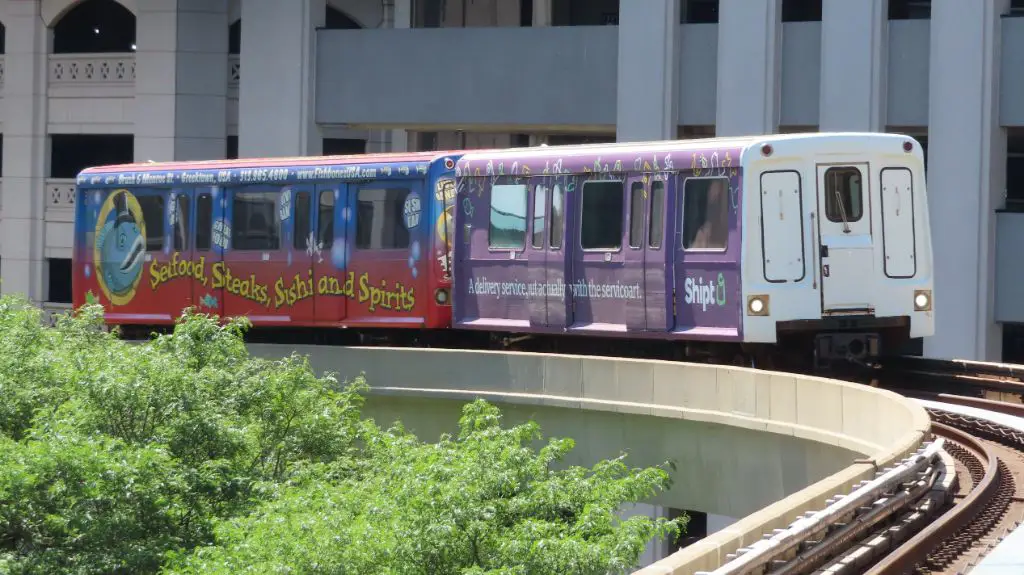Is There Still A People Mover In Detroit?
The Detroit People Mover is an elevated automated light rail system that operates in downtown Detroit, Michigan. First opened in 1987, the People Mover runs on a 2.94 mile circular loop with 13 stations connecting popular destinations like Joe Louis Arena, the Renaissance Center, and Greektown Casino.
The People Mover was originally conceived in the 1970s as part of a wider plan for mass transit in Detroit, but only the downtown circulator was built due to lack of funding. It began operation in 1987 after nearly a decade of planning and construction. The transit system was designed to relieve traffic congestion and improve mobility in the downtown area.
Over 30 years later, the Detroit People Mover continues operating today as an affordable and convenient way to get around downtown Detroit. It provides over 2 million rides per year and remains an iconic part of the city’s public transportation network.
What is the Detroit People Mover?
The Detroit People Mover is an automated monorail system that circles around downtown Detroit. It connects major venues, hotels, offices, and attractions in the downtown area.
The People Mover operates on a single 2.9 mile elevated track with 13 stations. The trains run clockwise in a loop and make a full circuit approximately every 15 minutes. As an automated system, the People Mover trains operate without any onboard staff or drivers.
The Detroit People Mover provides an easy way to get around downtown Detroit without a car. Riders can hop on and off at different stations along the route to reach destinations like Hart Plaza, the Renaissance Center, Greektown Casino, Comerica Park, and more.
When was the People Mover built?
The Detroit People Mover has a long history dating back to the 1970s. Construction first began in 1983 after years of planning and preparations. The People Mover was financed through a combination of federal, state and private funding sources.
The People Mover was designed as a fully automated light rail system that would help connect various destinations in downtown Detroit. The 2.9 mile elevated loop features 12 stations and was intended to be the first phase of a larger regional light rail system.
After several years of construction, the Detroit People Mover finally opened to the public on July 31, 1987. The original cost to ride was $0.50 when it first debuted. At the time, the People Mover was hailed as a revolutionary transportation system for Detroit.
Sources:
https://en.wikipedia.org/wiki/Detroit_People_Mover
https://gmrencen.com/history-of-the-doit-people-mover/
Who uses the People Mover today?
The Detroit People Mover is primarily used by three main groups:
Downtown workers make up a large portion of People Mover riders. Many downtown employees use the People Mover to commute to their offices, as well as for lunch breaks and meetings during the workday. Its convenient loop around downtown Detroit allows workers quick access to the central business district.
Tourists are another major user group of the People Mover. Its stops at venues like the Renaissance Center, Hart Plaza, Greektown, and midtown cultural institutions make it easy for visitors to access top attractions. The People Mover provides tourists with an elevated perspective of Detroit’s downtown.
People attending events are frequent riders, especially during weekends and evenings in downtown Detroit. Major events at Ford Field, Little Caesar’s Arena, Fox Theatre, and the riverfront draw attendees who rely on the People Mover. Its regular operating schedule outside of weekday commuting times accommodates event crowds.
How has ridership changed over time?
The Detroit People Mover saw peak ridership in the late 1980s after first opening. According to Wikipedia, “In the late 1980s the system saw average weekday ridership of 15,600 passengers, and up to 19,000 per day during special events,”* However, ridership declined in the 1990s as downtown Detroit saw an exodus of residents and businesses. With fewer jobs and amenities downtown, there was less need for public transit like the People Mover.

In recent years, ridership on the People Mover has increased again with the revitalization of downtown Detroit. More businesses, restaurants, apartments and events have brought more daily commuters and visitors needing transportation within the downtown area. According to Crain’s Detroit, “ridership increased from 361,000 in 2001 to 515,000 in 2011… Ridership was up 10 percent in 2012 over 2011.”** The People Mover continues to be an important transit option as downtown Detroit grows.
*https://en.wikipedia.org/wiki/Detroit_People_Mover
**https://www.crainsdetroit.com/article/20130106/NEWS/301069979/ridership-on-the-people-mover-tops-500000-as-detroit-banks-on-the
What is the route and schedule?
The Detroit People Mover operates on a 2.9 mile elevated loop in downtown Detroit with 13 stations total. It runs Monday through Friday from 5:30am to midnight and Saturday and Sunday from 6:30am to midnight.
The route makes a loop around downtown Detroit, connecting popular destinations like the Renaissance Center, Hart Plaza, Greektown, Comerica Park, and more. The People Mover operates in a one-way counterclockwise direction, with trains arriving every 5-15 minutes depending on the time of day.
Here is an overview of the route and schedule according to the Detroit People Mover website:https://www.thepeoplemover.com/station-guide
- Monday-Friday: 5:30am-midnight
- Saturday: 6:30am-midnight
- Sunday: 6:30am-midnight
- Trains every 5-15 minutes
Riders can view real-time arrivals on displays at each station to see exactly when the next train is coming. The convenient schedule allows people to use the People Mover throughout the day and evening for events, dining, and entertainment in downtown Detroit.
How much does it cost to ride?
The Detroit People Mover used to charge passengers a fare to ride. As recently as 2022, the cost was $0.75 per ride with discounted daily and monthly passes available (Fares & Passes | DPM). However, starting on January 2, 2024, the Detroit People Mover transitioned to a zero-fare system where all passengers can now ride for free with no payment or passes required (Riding Information: Fares | DPM). This change to a fare-free system makes the People Mover more accessible and aims to encourage increased ridership.
What is the future of the People Mover?
The Detroit People Mover has undergone upgrades and renovations in recent years to keep the system running smoothly. In 2021, the People Mover completed track replacement along the entire 2.9 mile elevated loop through downtown Detroit. This $5 million project was crucial for ensuring safe and reliable operations (https://detroit.urbanize.city/post/detroit-readers-weigh-future-people-mover).
There have also been proposals to expand the People Mover system beyond its current limited route. A 2022 map shows potential expansions to connect the People Mover to other major destinations like Midtown, the Detroit Riverwalk, and Belle Isle (https://detroitography.com/2022/07/29/map-existing-and-proposed-detroit-people-mover-expansions/). However, funding and logistical challenges have stalled any major expansion plans for now.
While the People Mover’s future is uncertain, the elevated rail continues operating today as an affordable method for getting around Downtown Detroit.
Is the People Mover still running in 2023?
Yes, the Detroit People Mover is still fully operational as of 2023. The automated monorail system continues to run daily along its 2.9 mile elevated track through downtown Detroit.
The People Mover originally opened in 1987 and has remained a fixture of Detroit’s public transportation system for over 35 years now. While ridership has fluctuated over the decades, the People Mover continues to operate and serve downtown commuters and visitors.
In 2022, the People Mover began a Zero Fare Pilot Program allowing passengers to ride for free throughout 2024. This program increased accessibility and removed barriers to ridership. According to the Detroit People Mover’s website, the system continues to run on its normal schedule with trains arriving every 5-15 minutes.
While the People Mover’s relevance and daily ridership numbers may vary over time, it remains an active and operational part of Detroit’s public transit infrastructure moving into 2023 and beyond.
Conclusion
After over 35 years in operation, the Detroit People Mover continues to provide transportation services in downtown Detroit. The automated monorail system loops 2.9 miles around the city’s business and entertainment districts, connecting 12 stations. Although ridership has declined from its peak, the People Mover still serves locals and visitors needing to easily get around downtown. It offers an affordable transportation option and runs 7 days a week. While some have questioned the system’s limited route and usefulness, the People Mover remains an iconic part of Detroit’s public transit network.
In summary, the Detroit People Mover opened in 1987 and still operates today as an elevated metro system in the city’s downtown area. It provides a unique way for riders to navigate downtown Detroit and connect to other forms of transit. Though the future expansion of the system remains uncertain, the People Mover continues serving its purpose of convenient downtown transportation.




